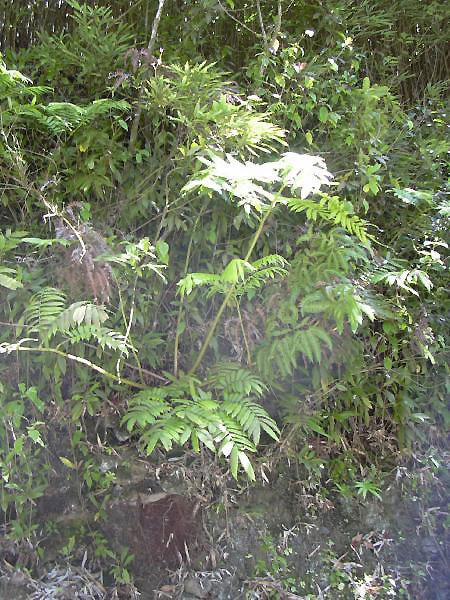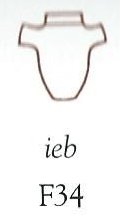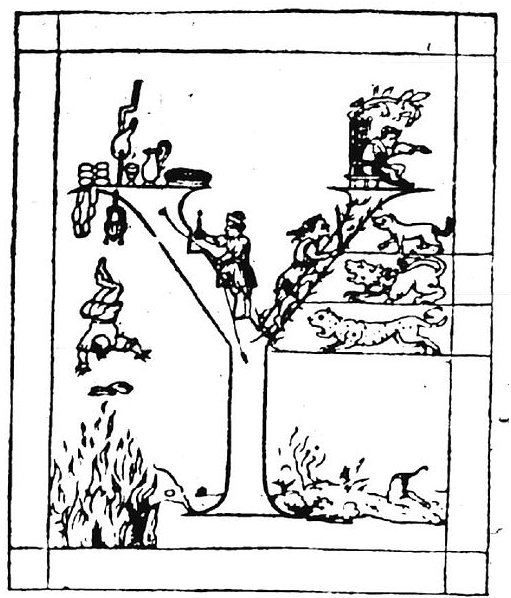Once again. There were 39 notches on the edge and 49 on the
back side of the prehistoric ivory plate:

39 + 49 = 88. At the time of
rongorongo Betelgeuze
(*88), the House of the Giant, was at
Nehenehe - presumably alluding to nahe the Giant Fern
and to nekeneke - a special term used for the Giant
Stone statues (moai) when they were 'walking'.
... I remember from somewhere in Heyerdahl's
books that he considered it significant that neke-neke
was a special word in the vocabulary of Easter Island, it meant
'walking without legs, walking by moving the weight this side
and that slowly advancing forward'. He had discovered the word
when he asked how the statues had been moved - they walked (neke-neke)
was the answer ...

.jpg)
The great fern (nahe) was also known as Mule's Foot. South of
the equator the sky dome was perceived upside down - where up became
down and down became up (as in ancient Egypt where south meant
up in the mountains and down was in the direction to the delta
of the Nile). This explains why Spica in Virgo was placed
above the waist line in the flag of Brazil, not below as in
the northern hemisphere:

Therefore, on Easter Island, they would
have observed Betelgeuze not as the right hand of Orion but as
his left foot. When inverting a figure the direction right
becomes left and vice versa.

... Of them all, Taane Mahuta, the god
of the forests, was the most determined; he set his sturdy feet
upon his father's chest, and braced his upper back and shoulders
against the bosom of his mother. He pushed; and they parted. So
the world, as the Maori understand it, came into being
...
The name Te Kioe Uri (the Dark Rat) presumably
indicated they on Easter Island associated this kuhane
station with the Rat season in China. In the Hindu nakshatra
system Betelgeuze was at Ardra = the Moist One.
|
10 |
Girl |
ε Aquarii
(Albali) |
Bat |
Jan 29 (394) |
| 11 |
Emptiness |
β Aquarii
(Sadalsud) |
Rat |
Febr 9 (405) |

... In China,
with Capricornus, Pisces, and a part of Sagittarius,
it [Aquarius] constituted the early Serpent, or
Turtle, Tien Yuen; and later was known as
Hiuen Ying, the Dark Warrior and Hero, or Darkly
Flourishing One, the Hiuen Wu, or Hiuen
Heaou, of the Han dynasty, which Dupuis gave as
Hiven Mao. It was a symbol of the emperor
Tchoun Hin, in whose reign was a great deluge;
but after the Jesuits came in it became Paou Ping,
the Precious Vase. It contained three of the sieu,
and headed the list of zodiac signs as the Rat,
which in the far East was the ideograph for 'water',
and still so remains in the almanacs of Central
Asia, Cochin China, and Japan ...
 |
Sadalsud (405) - Betelgeuze (168 = 24 weeks) = 237 = 8 * 29½ + 1.
*88 (Betelgeuze at the time of rongorongo) - *41
(precessional distance down to the time of Bharani) = *47,
and 39 < 47 < 53 → Te Kioe Uri. At
the time of rongorongo Sadalsud rose with the Sun in day 405
(right ascension day *325 - alluding to the Julian spring equinox in 'March 25),
and at the time of Bharani Sadalsud would have risen with the Sun in day *325 - *41 = *284,
viz. at Peke
Tau O Hiti.
|
Nga Kope Ririva Tutuu Vai |
- |
|
365 |
A Te Taanga |
|
Te Pu Mahore |
1 |
- 13 |
- 378 |
A Hau Maka O Hiva
|
|
Te Poko Uri |
2 |
14 - 26 |
- 391 |
A
Hau Maka I
[Sic!]
Hiva |
|
Te Manavai |
3 |
- 39 |
- 404 |
A Hau Maka O Hiva |
|
Te Kioe Uri (The Dark Rat) |
4 |
- 52 |
- 417 |
|
Te Piringa Aniva |
5 |
- 65 |
- 430 |
|
Te Pei |
6 |
- 78 |
- 443 |
|
Te Pou |
7 |
79 -
91 |
- 456 |
|
Hua Reva |
8 |
- 104 |
- 469 |
|
Akahanga |
9 |
- 117 |
- 482 |
|
Hatinga Te Kohe |
10 |
- 130 |
- 495 |
|
Roto Iri Are |
11 |
- 143 |
- 508 |
|
Tama He Ika Kino He Ihu Roroa |
12 |
- 156 |
- 521 |
- |
|
One Tea
|
13 |
-
169 |
-
534 |
A Hau Maka O Hiva |
|
Hanga Takaure |
14 |
-
182 |
-
547 |
|
Poike |
15 |
-
195 |
-
560 |
|
Pua Katiki |
16 |
-
208 |
-
573 |
|
Maunga Teatea |
17 |
- 221 |
- 586 |
|
Mahatua |
18 |
-
234 |
-
599 |
|
Taharoa |
19 |
-
247 |
-
612 |
|
Hanga Hoonu |
20 |
-
260 |
-
625 |
|
Rangi Meamea |
21 |
-
273 |
-
638 |
|
Peke Tau O Hiti |
22 |
-
286 |
-
651 |
|
Maunga Hau Epa |
23 |
-
299 |
-
664 |
|
Oromanga |
24 |
-
312 |
-
677 |
|
Hanga Moria One |
25 |
-
325 |
-
690 |
|
Papa O Pea |
26 |
-
338 |
-
703 |
|
Ahu Akapu |
27 |
- 351 |
- 716 |
|
Te Pito O Te Kainga
|
28 |
-
364 |
-
729 |
Thus Sadalsud should be placed at the dream soul station Peke Tau O Hiti:
Peke. 1. To
bite (of fish or lobster pecking at fishhook). 2. To
repeat an action: he-peke te rua; ina ekó peke-hakaou
te rua don't you do it a second time; ina ekó
peke hakaou-mai te rua ara, don't come back here
again. Vanaga. To succeed, to follow. Pau.: peke,
to follow, to accompany. Ta.: pee, to follow.
Churchill. Mgv.: Pekepeke. 1. The tentacles of
the octopus retracted. Mq.: peke, to tuck up the
clothes. Ma.: pepeke, to draw up the legs and
arms. 2. A crab. Ha.: pee-one, a crab that
burrows in the sand. Churchill.
Hiti. 1. To show itself again, to reappear (of
the new moon, of a constellation - meaning uncertain).
2. Said of thin, tough-fleshed fish of indifferent
taste: ika hiti. 3. Said of fish when they come
to the stones of the shore for insects among the
seaweed: he hiti te ika. 4. To reproach someone
for his ingratitude. Vanaga. 1. To rise, to appear, to
dawn; hitihaga, rising; hitihaga roa,
sunrise; hitihiti, to dawn; horau hitihiti,
break of day; hakahiti ki te eeve, to show the
buttocks. 2. Puffed; gutu hiti, thick lips.
Churchill.
|
Peke Tau O Hiti (274-286) |
|
DEC 7 |
8 |
9 |
10 |
11 (345) |
12 (*266) |
 |
 |
 |
 |
 |
 |
|
Gb2-6 (32) |
Gb2-7 |
Gb2-8 |
Gb2-9 |
Gb2-10 (229 +36) |
Gb2-11 (266) |
|
BUNDA (Foundation)
/ KAKKAB
NAMMAΧ (Star of Mighty Destiny) |
θ Piscis Austrini (330.1), λ Octantis
(330.7) |
|
Al Sa'd al Su'ud-22 (Luckiest of the Lucky)
/
Emptiness-11 (Rat)
TSIN =
36 Capricorni
(325.2),
ALPHIRK (The Flock) = β Cephei
(325.7),
SADALSUD
=
β
Aquarii,
ξ
Gruis (325.9) |
no star listed (326) |
CASTRA
= ε Capricorni
(327.2),
BUNDA
= ξ Aquarii
(327.5)
SIRIUS (α Canis Majoris)
|
Mahar sha hi-na Shahū-26 (Western One in the
Tail of the Goat)
NASHIRA
=
γ
Capricorni
(328.0),
ν
Oct. (328.3), AZELFAFAGE
= π¹ Cygni,
κ
Capricorni (328.7 |
Arkat sha hi-na Shahū-27 (Eastern One in the
Tail of the Goat)
ENIF
(The Nose) = ε Pegasi, ERAKIS = μ Cephei
(329.2),
46 CAPRICORNI,
JIH
(the Sun) =
κ
Pegasi
(329.3),
ι
Piscis Austrini (329.4),
λ
Capricorni (329.6),
ν
Cephei (329.7),
DENEB ALGIEDI
=
δ
Capricorni
(329.8)
*288.0 = *329.4 - *41.4 |

... In
China, with Capricornus, Pisces, and a part
of Sagittarius, it [Aquarius] constituted
the early Serpent, or Turtle, Tien Yuen;
and later was known as Hiuen Ying,
the Dark Warrior and Hero, or Darkly
Flourishing One, the Hiuen Wu, or
Hiuen Heaou, of the Han dynasty, which
Dupuis gave as Hiven Mao. It was a
symbol of the emperor Tchoun Hin, in
whose reign was a great deluge; but after
the Jesuits came in it became Paou Ping,
the Precious Vase. It contained three of the
sieu, and headed the list of zodiac signs as
the Rat, which in the far East was
the ideograph for 'water', and still so
remains in the almanacs of Central Asia,
Cochin China, and Japan ... |
|
Febr 9
(40) |
10 |
11 |
12 (408) |
13 (*329) |
All
Hearts' Day |
|
°Febr 5
(36) |
6 |
7 |
8 (404) |
9 (*325) |
10 (41) |
|
'Jan 13
(378) |
14 |
15 (*300) |
16 |
17 |
18 (383) |
|
"Dec 30
(364) |
31 |
"Jan 1 (366) |
2 |
3 (*288) |
4 |
|
364 - 100
= 264 |
265 |
266 |
408 - 141
= 267 |
268 |
269 |
|
... On February 9 the Chorti Ah K'in,
'diviners', begin the agricultural year.
Both the 260-day cycle and the solar year
are used in setting dates for religious and
agricultural ceremonies, especially when
those rituals fall at the same time in both
calendars. The ceremony begins when the
diviners go to a sacred spring where they
choose five stones with the proper shape and
color. These stones will mark the five
positions of the sacred cosmogram created by
the ritual. When the stones are brought back
to the ceremonial house, two diviners start
the ritual by placing the stones on a table
in a careful pattern that reproduces the
schematic of the universe. At the same time,
helpers under the table replace last year's
diagram with the new one. They believe that
by placing the cosmic diagram under the base
of God at the center of the world they
demonstrate that God dominates the universe.
The priests place the stones in a very
particular order. First the stone that
corresponds to the sun in the eastern,
sunrise position of summer solstice is set
down; then the stone corresponding to the
western, sunset position of the same
solstice. This is followed by stones
representing the western, sunset position of
the winter solstice, then its eastern,
sunrise position. Together these four stones
form a square. They sit at the four corners
of the square just as we saw in the Creation
story from the Classic period and in the
Popol Vuh. Finally, the center stone is
placed to form the ancient five-point sign
modern researchers called the quincunx ...


... In
the inscriptions of Dendera, published by
Dümichen, the goddess Hathor is
called 'lady of every joy'. For once,
Dümichen adds: Literally ... 'the lady of
every heart circuit'. This is not to say
that the Egyptians had discovered the
circulation of the blood. But the
determinative sign for 'heart' often figures
as the plumb bob at the end of a plumb line
coming from a well-known astronomical or
surveying device, the merkhet.
Evidently, 'heart' is something very
specific, as it were the 'center of gravity'
...
See Aeg.Wb. 2, pp.
55f. for sign of the heart (ib) as
expressing generally 'the middle, the
center'.

And this
may lead in quite another direction. The
Arabs preserved a name for Canopus - besides
calling the star Kalb at-tai-man
('heart of the south') ... Suhail el-wezn,
'Canopus Ponderosus', the heavy-weighing
Canopus, a name promptly declared
meaningless by the experts, but which could
well have belonged to an archaic system in
which Canopus was the weight at the end
of the plumb line, as
befitted its important position as a heavy
star at the South Pole of the 'waters
below'. Here is a chain of inferences which
might or might not be valid, but it is
allowable to test it, and no inference at
all would come from the 'lady of every joy'.
The line seems to state that Hathor
(= Hat Hor, 'House of Horus')
'rules' the revolution of a specific
celestial body - whether or not Canopus is
alluded to - or, if we can trust the
translation 'every', the revolution of all
celestial bodies. As concerns the identity
of the ruling lady, the greater possibility
speaks for Sirius, but Venus cannot be
excluded; in Mexico, too, Venus is called
'heart of the earth'. The reader is invited
to imagine for himself what many thousands
of such pseudo-primitive or poetic
interpretations must lead to: a disfigured
interpretation of Egyptian intellectual life
... |
|
CLOSE TO
THE FULL MOON: |
|
JUNE 7 |
8 (*79) |
9 |
10 (161) |
11 |
12 |
|
The
Knot (Ukdah) |
Rishu A.-13 (Head of the Lion)
ψ Leonis (146.4),
RAS ELASET AUSTRALIS
= ε Leonis
(146.6)
*105.0 = *146.4 - *41.4 |
VATHORZ PRIOR
= υ Carinae
(147.9) |
|
Star-25 (Horse) /
ANA-HEU-HEU-PO-5 (Pillar where debates were
held)
ALPHARD (The Horse)
=
α
Hydrae
(142.3),
ω
Leonis (142.6),
τ¹
Hydrae (142.7) |
Al Tarf-7 (The End)
ψ
Velorum (143.3),
ALTERF
=
λ
Leonis,
τ²
Hydrae (143.4),
ξ
Leonis (143.5)
*102.0 = *143.4 - *41.4 |
A Hydrae
(144.1)
VEGA (α Lyrae)
|
UKDAH
(Knot) = ι Hydrae
(145.4), κ Hydrae (145.5),
SUBRA = ο Leonis
(145.8)
*104.0 = *145.4 - *41.4 (= *288 - *184) |
|
... For
they say that the course of human life
resembles the letter Y, because every one of
men, when he has reached the threshold of
early youth, and has arrived at the place
'where the way divides itself into two
parts', is in doubt, and hesitates, and does
not know to which side he should rather turn
himself ...

|
|
Aug 10 |
11 |
12 |
13 (*145) |
14 |
15 (227 →
π) |
|
°Aug 6 |
7 |
8 (220) |
9 |
10 |
11 |
|
'July 14 |
15 |
16 |
*118 = 4 * 29½ |
18 |
19 (200) |
|
SIRIUS |
"July 1 |
2 |
*104 = 4 * 26 |
4 (185) |
Te
Anakena 5 |
|
At the time of rongorongo
Sirius stood like a pillar at day zero in
June 30, 181 (*101), and 101 days later came
Spica in October 9, 282 (*202). The flag of
Brazil has uplifted Spica with a little dot
far down marking Dramasa (σ
Octantis, the South Pole star). In between
we can perceive the Southern Cross, and
between Spica and the Southern Cross is the
Tail of the Hydra (γ
Hydrae, Al Dhanab al Shuja) - in the
day before Spica but below the curved band.
To the right is the Scorpion with Antares
placed at the opposite side compared to
Procyon (α Canis
Minoris), below O in ORDEM. Alphard (α
Hydrae) is below M. Sirius and 4 more stars
in Canis Major are noted below Alphard,
together with Canopus. In addition to 8
stars in the Scorpion we can also see 3 more
stars to the left which mark the Southern
Triangle (Triangulum Australe).
Altogether there are 26 + 1 = 27 stars:

|
|


.jpg)








